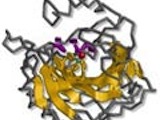Nathalie Le Roy PhD thesis
 Carbonic anhydrase in calcium carbonate biomineralizations: activity, expression and evolution
Carbonic anhydrase in calcium carbonate biomineralizations: activity, expression and evolution
Defended on the 28th June 2011
Funding: Ministerial grant
Supervisor: Frédéric Marin
Started in October 2007
Abstract
The a-carbonic anhydrases (CA, EC 4.2.1.1) form a family of metalloenzyme belonging to the large CA superfamily (a, ß, d, ? and ? families). CAs catalyse the reversible reaction of carbon dioxide hydration, releasing one proton and one bicarbonate ion. They play an essential role in the regulation of intra and extracellular pH in living organisms. Among metazoans, CAs are present in numerous tissues and functions, including the processes of calcium carbonate biomineralisation. Our evolutionary study of a-CAs has been discussed with the phylogenetic analysis of a large sample of metazoan, especially non-vertebrates, CA sequences. The phylogeny shows a divergent evolution of the a-CAs involved in the calcium carbonate biomineralisation process. Subsequently, using biochemical, molecular and structural approaches, we have tried to detect CAs in three nonvertebrate calcifying models: (1) the shell of the freshwater bivalves Unio spp., (2) the shell of the seawater gastropod Haliotis tuberculata and (3) the gastroliths of the crayfishes Pacifastacus leniusculus and Cherax quadricarinatus. A specific CA activity and CA peptides have been characterized in the acid-soluble organic matrix of the shell of Unio spp. In the calcifying mantle tissue of Haliotis tuberculata, we have sequenced two mRNA encoding two novel secreted CAs, htCA1 and htCA2. However, these CAs have not been detected in the H. tuberculata shell matrix. At last, in the crayfishes we have not detected CAs, neither in the gastroliths nor in the mineralizing tissue. CAs could be absent from the gastrolith mineralization. In biomineralisation processes, we identified at least three modes of CA functioning: (1) CA secreted and incorporated in the mineralizing matrix; (2) CA secreted but not incorporated in the mineralizing matrix; and (3) CA apparently absent from the extracellular compartment.
Keywords
carbonic anhydrase, biomineralisation, calcium carbonate, evolution, molluscs, crayfishes, molecular biology, biochemistry
Jury
Philippe Dubois (université libre de Bruxelles)
Jean-Marc Lebel (université de Caen Basse-Normandie)
Stéphanie Auzoux-Bordenave (université Pierre et Marie Curie)
Christian Milet (Muséum national d’histoire naturelle)
Jean-Yves Sire (université Pierre et Marie Curie)
Pascal Neige (université de Bourgogne)
Frédéric Marin (université de Bourgogne)
- extrait:
- lien_externe:
- kc_data:
- a:8:{i:0;s:0:"";s:4:"mode";s:0:"";s:3:"css";s:0:"";s:9:"max_width";s:0:"";s:7:"classes";s:0:"";s:9:"thumbnail";s:0:"";s:9:"collapsed";s:0:"";s:9:"optimized";s:0:"";}
- kc_raw_content:
 Carbonic anhydrase in calcium carbonate biomineralizations: activity, expression and evolution
Carbonic anhydrase in calcium carbonate biomineralizations: activity, expression and evolutionDefended on the 28th June 2011
Funding: Ministerial grant
Supervisor: Frédéric Marin
Started in October 2007
Abstract
The a-carbonic anhydrases (CA, EC 4.2.1.1) form a family of metalloenzyme belonging to the large CA superfamily (a, ß, d, ? and ? families). CAs catalyse the reversible reaction of carbon dioxide hydration, releasing one proton and one bicarbonate ion. They play an essential role in the regulation of intra and extracellular pH in living organisms. Among metazoans, CAs are present in numerous tissues and functions, including the processes of calcium carbonate biomineralisation. Our evolutionary study of a-CAs has been discussed with the phylogenetic analysis of a large sample of metazoan, especially non-vertebrates, CA sequences. The phylogeny shows a divergent evolution of the a-CAs involved in the calcium carbonate biomineralisation process. Subsequently, using biochemical, molecular and structural approaches, we have tried to detect CAs in three nonvertebrate calcifying models: (1) the shell of the freshwater bivalves Unio spp., (2) the shell of the seawater gastropod Haliotis tuberculata and (3) the gastroliths of the crayfishes Pacifastacus leniusculus and Cherax quadricarinatus. A specific CA activity and CA peptides have been characterized in the acid-soluble organic matrix of the shell of Unio spp. In the calcifying mantle tissue of Haliotis tuberculata, we have sequenced two mRNA encoding two novel secreted CAs, htCA1 and htCA2. However, these CAs have not been detected in the H. tuberculata shell matrix. At last, in the crayfishes we have not detected CAs, neither in the gastroliths nor in the mineralizing tissue. CAs could be absent from the gastrolith mineralization. In biomineralisation processes, we identified at least three modes of CA functioning: (1) CA secreted and incorporated in the mineralizing matrix; (2) CA secreted but not incorporated in the mineralizing matrix; and (3) CA apparently absent from the extracellular compartment.
Keywords
carbonic anhydrase, biomineralisation, calcium carbonate, evolution, molluscs, crayfishes, molecular biology, biochemistry
Jury
Philippe Dubois (université libre de Bruxelles)
Jean-Marc Lebel (université de Caen Basse-Normandie)
Stéphanie Auzoux-Bordenave (université Pierre et Marie Curie)
Christian Milet (Muséum national d'histoire naturelle)
Jean-Yves Sire (université Pierre et Marie Curie)
Pascal Neige (université de Bourgogne)
Frédéric Marin (université de Bourgogne)
